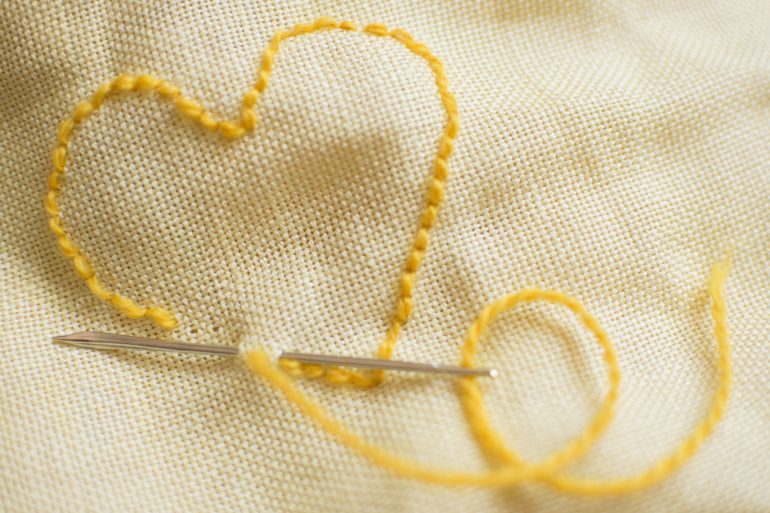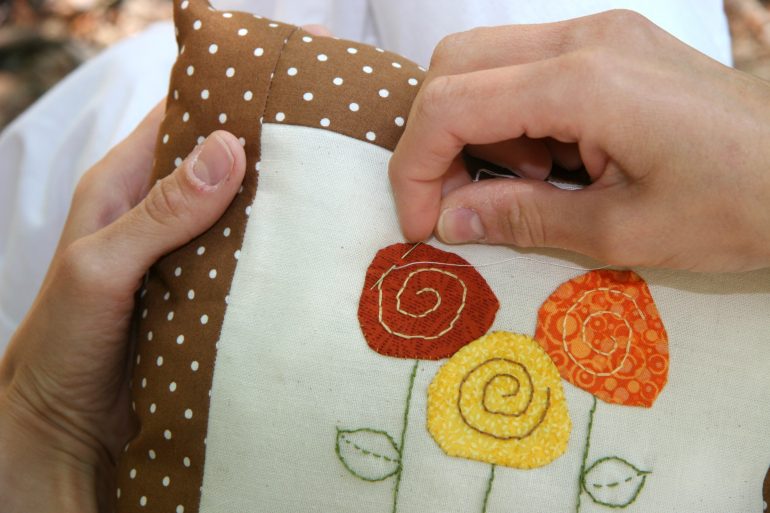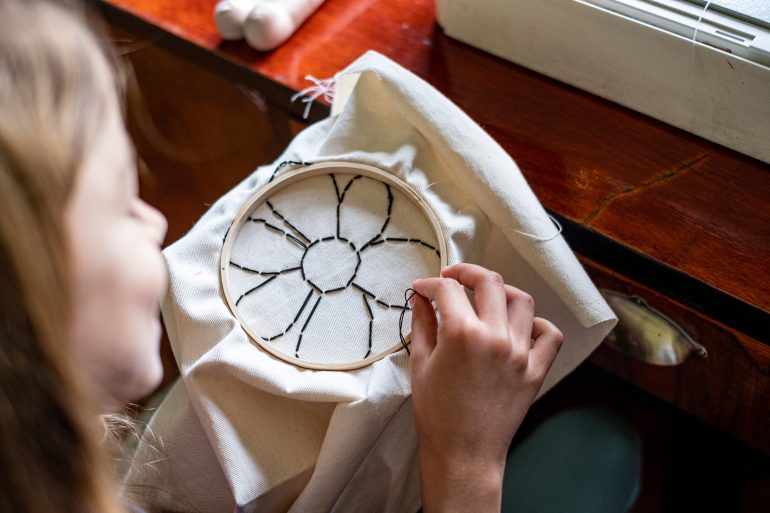At its core, answering the question ‘what is embroidery’ is pretty straightforward. It’s the art of adding decorative designs, motifs and embellishments to fabric using a needle and thread. But it’s more than just a way to make material prettier. It’s a captivating world, one which brings fabrics to life and creates something personal, enduring and beautiful.
For those just beginning to unravel the world of embroidery essentials, the vast array of techniques, materials, and designs can seem overwhelming. But don’t worry, because mastering this art is as much about patience and practice as it is about understanding the basics.
In this guide, we’ll demystify the world of embroidery for beginners, offering tips, tricks, and project ideas. By the time you reach the end, you’ll have the answer to the question ‘what do I need to start embroidery’ and you’ll be itching to start stitching!
A Short History of Embroidery

Embroidery floss, thread, colors, close up. (Credit: Kinga Krzeminska via Getty Images)
The word ‘embroidery’ comes from the French word ‘broderie,’ which relates to embellishing or ornamenting fabric. The craft’s deep-rooted connection with different cultures showcases how techniques and styles have evolved, yet its essence remains consistent: the art of decorating fabric with needle and thread.
Remarkably, the answer to ‘what do you need for embroidery’ hasn’t changed since humans first started embellishing fabric, possibly as early as five thousand years ago. A piece of fabric, a needle and some thread.
The art form developed independently around the world. Embroidered clothing, burial items, and hangings have been discovered in Egyptian tombs, some dating back to around 3000 BC or earlier. Similarly, the Middle East has a rich tradition of textile arts. Textile production from this region, both decorative and functional, has been found from ancient times, and excavations at Mohenjo-daro, one of the primary settlements of the ancient Indus Valley Civilisation in the Indian subcontinent, have unearthed evidence of such fabrics.
China is renowned for its early silk embroideries with distinct styles and techniques emerging in different regions, such as Su embroidery from Suzhou and Yue embroidery from Guangdong.
In Europe, ancient Greeks, Romans, and Vikings all crafted embroidered fabrics. While ‘what is embroidery’ may have nuanced answers depending on the origin, the embroidery essentials have remained remarkably similar through the ages.
What do you need for Embroidery?

Embroidery crafting supplies (Credit: Annie Otzen via Getty Images)
Like other forms of handicrafts, this type of needlework doesn’t require much equipment or a large financial outlay. If you want to know how to start embroidery, read on.
You can buy beginner kits from craft or hobby shops which usually have everything you need to get started, or, you can stock up on your embroidery essentials.
Fabric
Aida cloth is a common starting point because it has easily countable squares. Cotton muslin is good to practise freehand techniques and you can also buy linen that has been specifically manufactured for use in embroidery.
Embroidery Hoop
An embroidery hoop, usually made of wood, is an adjustable round frame that keeps your fabric taut while you’re embroidering.
Needles
Depending on the weight of your thread, different embroidery needles, known as crewel needles, are required. They’re very sharp in order to move easily through fabric and have large eyes so they’re easy to thread.
Thread
Embroidery thread is available in a wide range of weights and colours. One of the most common threads for beginners is known as embroidery floss. It’s made of six strands of cotton which means you can adjust the thickness of your stitches by using more or fewer strands. For delicate work, you might use just one or two strands, while for bolder stitches or filling, you might use all six. It’s suitable for a wide range of stitches, from basic ones like the running stitch or backstitch to more intricate ones like the French knot or satin stitch. For beginners asking ‘what do I need to start embroidery’, the use of cotton floss provides an ideal balance between flexibility and simplicity. As you gain more experience and become comfortable with various techniques, you might choose to explore other types of threads and materials. But embroidery floss remains a foundational element in the toolkit of many, from novices to experts.
Scissors, Thimbles and Beyond
The other things you’ll need in your ‘how to start embroidery’ toolbox includes a pair of scissors, patterns, water-soluble pens to transfer or mark designs onto your fabric, and a thimble to protect your fingers when pushing needles through thicker fabrics. You’ll also need resources to help you understand the basic stitches and techniques, whether online or from books and magazines.
A Stitch in Time…

Embroidered yellow heart. (Credit: Jamie Grill via Getty Images)
‘What do you need for embroidery’ has a number of answers but perhaps the most important one, and one that will stand you in good stead throughout your needlework journey is a knowledge of stitches.
Embroidery encompasses a vast array of stitches, but here are some of the basic ones that are foundational for anyone delving into this craft. These basic stitches can be the building blocks for a wide range of embroidery designs.
Running Stitch
How to start embroidery starts here. A simple stitch where the needle goes up and down through the fabric, creating a dashed line. Often used for outlining or making straight and curved lines.
Backstitch
Similar to the running stitch, but each stitch starts where the last one ended. It creates a continuous line and is often used for outlining and text.
Split Stitch
The needle comes up through the fabric and goes down a short distance away. When coming up again, the needle splits the previous stitch. This creates a slightly textured, continuous line.
Chain Stitch
Creates a series of looped stitches that form a chain-like pattern. It’s versatile and can be used for outlines, filling, and decorative lines.
Satin Stitch
Straight stitches are placed closely together to cover an area of fabric entirely, giving it a smooth, satin-like appearance. It’s used for filling in shapes.
French Knot
A small knot used for dot-like details or texture. The needle comes up through the fabric, the thread is wound around the needle a couple of times, and then the needle goes back down close to where it came up.
Lazy Daisy
A looped stitch that creates petal shapes, primarily used for making flowers. It’s essentially a detached chain stitch.
Blanket Stitch (or Buttonhole Stitch)
A border stitch used on the edges of fabric, often in blanket-making. It creates a series of interlinked stitches that look like the teeth of a comb.
Stem Stitch
A line stitch used mainly for creating curved lines, such as plant stems. The thread always remains to one side of the stitching line, giving a slightly twisted appearance.
Long & Short Stitch
A filling stitch used for shading. It’s a series of alternating long and short straight stitches, often used in thread painting to create gradients.
Basic Embroidery Project Ideas

A pillow being embroidered with flowers. (Credit: diephosi via Getty Images)
One of the most fun embroidery ideas for beginners is making DIY cushion covers with basic patterns. Embroidery letters on fabric are a great way to practise your backstitch and simple flowers allow you to attempt Lazy Daisy.
Adding embellishments to clothes creates a whole new look, from small flowers on a plain scarf to stitching sequins or pretty buttons onto kids’ t-shirts. How about adding new designs to a tote bag or even embroidering small designs onto thank you cards for a unique and personal touch.
The beauty of embroidery is that you’ll never run out of ideas. So if you’re looking for an answer to the question ‘what is embroidery’, you’ve found it!
Unravelling the Threads of Creativity

Young girl doing some embroidery needlework. (Credit: StockPlanets via Getty Images)
Embroidery, with its myriad stitches, kaleidoscope of colours, and infinite possibilities, beckons creators from all walks of life. It’s not just about beautifying fabric; the journey of how to start embroidery is one of patience, precision, and personal expression.
For beginners, the world of embroidery might seem vast and overwhelming, but remember: every master embroiderer started with a single stitch. With the foundational knowledge of techniques, coupled with the endless project ideas available, there’s no limit to the tapestries you can weave. Whether it’s a delicate flower or an intricate landscape, the canvas awaits your story. So thread that needle, embrace the artistry, and let embroidery be the thread that stitches together your moments of inspiration.












